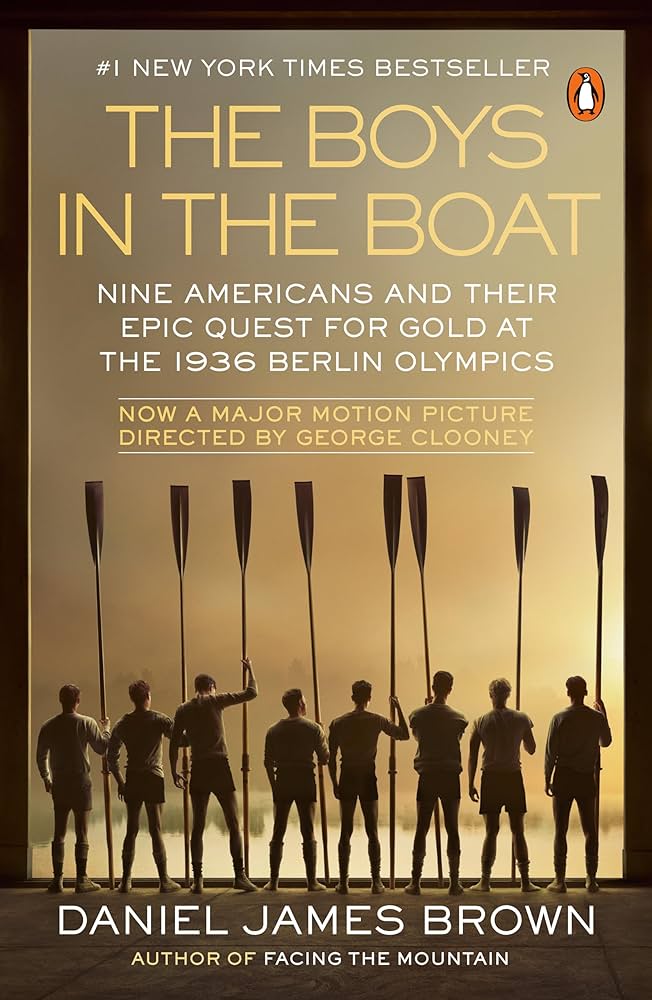
Most people are familiar with this story of the rowing team from the University of Washington that won the 1936 Olympics in Berlin. A good example of narrative nonfiction, it is a well-researched, factual account that is eminently readable.
All the basic elements of good prose are here: the clarity of well-constructed sentences, good pacing through varying sentence structure, consistency achieved by presenting information in a logical sequence that the reader can easily follow. Beyond these, I want to point out a few methods that Brown employed to make it so absorbing a read.
One is that he centers the book on one character: Joe Rantz, a student from a working class background, left to fend for himself at a young age after his remaining parent abandoned him in the small town of Sequim, Washington. Recruited by rowing coach Alvin Ulbrickson, he attended the University of Washington; however, for him to aspire to a coveted spot on the rowing team meant competing against the privileged young men from expensive prep schools who embodied the elite image of rowing.
With a main character to root for as he confronts the physical challenges of competitive rowing and the psychological challenges of the U.S. class system, Brown begins to introduce other people of interest. One at a time—giving us a chance to get to know them before moving on—he gives us Ulbrickson, the head coach; Robert Mox, coxswain; Donald Hume, stroke; and freshman coach Tom Bolles.
Another way Brown makes the story so compelling is through making the Olympic race the climactic moment near the end of the book. Even though most readers know the outcome before starting the book, the suspense of waiting to see how it happens is immense. The suspense is fed by all the minor trials and setbacks, all the races against Washington’s main rival, California, and the Ivy League founders of the Rowing League, Columbia, Cornell, and Pennsylvania. Adding to the tension is the fact that the story takes place during the depths of the Great Depression.
These details are proof of the extensive research the author completed. The details that Brown chooses to include—the tip of the iceberg—serve the story by giving the reader a fuller picture of the time and the character’s motivations. In particular, the details about the construction of the shells are presented in context and in such a way as to fascinate any reader.
Three themes of the book adds to its hold the reader. One is the portrait of poverty at the time (though it’s certainly as bad as today in some areas). Joe’s struggle to get by as an abandoned teenager, as well as his and some of his teammates’ difficulty in coming up with the necessary funds, give the reader a better appreciation of the effects of the Depression.
A second theme is the difference between today and life in 1930s. Beyond economics, there is the relative isolation, with only radio and newspapers as media. The physical isolation comes through in the description of the trip to the East Coast to compete in the League championship. It is Joe’s first train trip and his first view of other parts of the country.
The final theme I want to point out is the context of the 1936 Olympics itself: Hitler’s Germany. The Berlin Olympics served Hitler’s goal of presenting Nazi Germany as a superior nation. Beyond hiding evidence of the Nazi’s abuses, the image of Berlin was meticulously orchestrated by propaganda minister Joseph Goebbels and filmed by Leni Riefenstahl as propaganda to prove to the world Aryan “purity” and Nazi supremacy. However familiar we may already be with this context, the details and the engaging way they are presented give us a deeper understanding of this early foray in marketing an image and a precursor of the horror to come. They also add further pressure to the U.S. team in the climactic race, as they strive to overcome the handicaps imposed by the Nazi organisers and beat their German rivals.
Narrative nonfiction occupies a particularly fertile middle ground between fiction and nonfiction. And it’s even more challenging for an author who must undertake the necessary research and abide by the limitations of accuracy imposed by nonfiction, while also employing the tools of a fiction writer. Brown ably demonstrates proficiency in all of these areas. This book deserves its accolades.
If you’ve read this popular book, what was your main takeaway?